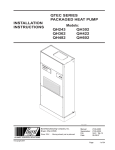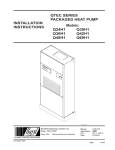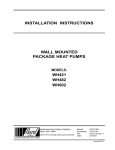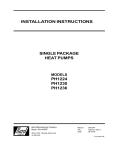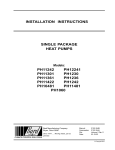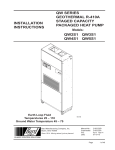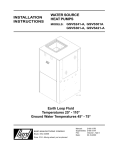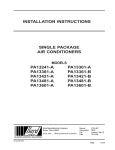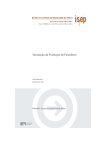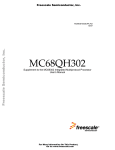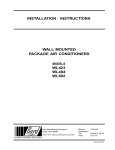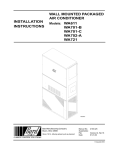Download Bard QH422 Specifications
Transcript
INSTALLATION INSTRUCTIONS QTEC SERIES PACKAGED HEAT PUMP Models: QH243 QH302 QH362 QH422 QH482 QH602 MIS-1554 Bard Manufacturing Company Bryan, Ohio 43506 Since 1914 . . . Moving ahead, just as planned. Manual: Supersedes: File: Date: 2100-420E 2100-420D Vol II Tab 14 06-02-04 © Copyright 2004 CONTENTS Getting Other Information and Publications For more information, contact these publishers: .......... 1 QTEC General Information QTEC Model Nomenclature .......................................... 2 Shipping Damage ......................................................... 6 Unit Removal From Skid .............................................. 6 Handling Unit After Removal From Skid ....................... 7 General ......................................................................... 7 Minimum Installation Height ......................................... 7 Duct Work .................................................................... 9 Filters ............................................................................ 9 Fresh Air Intake .......................................................... 10 Condensate Drain ...................................................... 10 Service Light ............................................................... 11 Installation Instructions Mounting the Unit ....................................................... 12 Wiring — Main Power ................................................. 13 Wiring — Low Voltage Wiring ..................................... 13 Low Voltage Connections ........................................... 14 Start Up Description of Standard Equipment ............................... 19 Optional CFM (QH361QH421and QH481 Only) ............ 19 Important Installer Note .................................................. 19 Phase Monitor ................................................................ 19 Three Phase Scroll Compressor Start Up Information ................................................................ 19 Service Hints .................................................................. 20 Mist Eliminator Service .................................................. 20 Vent Options .................................................................. 21 Sequence of Operation .................................................. 24 Optional Climate Controls Sequence of Operation .............................................................. 24 Pressure Service Ports .................................................. 24 Defrost Cycle ................................................................. 25 Troubleshooting Solid State Heat Pump Control Troubleshooting Procedure ...................................................................... 27 Checking Temperature Sensor ...................................... 27 Fan Blade Setting Dimensions ...................................... 28 Refrigerant Charge ........................................................ 28 Pressure Charts ...................................................... 29 - 30 Figures Figure 1 Figure 2 Figure 3 Figure 4 Figure 5 Figure 6 Figure 7 Figure 8 Figure 9 Figure 10 Figure 11 Figure 12 Figure 13 Figure 14 Figure 15 Figure 16 Figure 17 Figure 18 Figure 19 Figure 20 Figure 21 Figure 22 Figure 23 i Unit Dimensions .......................................... 5 Air Seal on Bottom of Unit ........................... 6 Removal of Unit From Skid ......................... 6 Unit on Appliance Cart for Moving ............... 7 Installation With Free Blow Plenum ............ 8 Ducted Application ....................................... 8 Supply Duct Connections ............................ 9 Filter Location .............................................. 9 Side Drain .................................................. 10 Optional Rear Drain ................................... 10 Rear Drain (Top View) ............................... 11 Unit Mounting ............................................ 11 Screws in Wheels of Unit .......................... 12 Component Location ................................. 13 Thermostat Plug Terminals ........................ 15 Thermostat Wiring Diagram "X" Option .... 16 Thermostat Wiring Diagram "A" Option .... 17 Thermostat Wiring Diagram "D" Option ... 18 Fresh Air Damper Removal ....................... 22 QERV Removal ......................................... 23 Heat Pump Control Board ......................... 24 Low Pressue Control Bypass Timer ........... 25 Fan Blade Setting ...................................... 28 Tables Table 1 Table 2 Table 2A Table 3 Table 4 Factory Built-In Electric Heat Table .............. 2 Electrical Specifications ................................ 3 Electrical Specifications ................................ 4 Operating Voltage Range ........................... 13 Wall Thermostats and Subbase Combinations .............................................. 15 Table 5 Troubleshooting .......................................... 26 Table 6 Temperature vs Resistance of Temperature Sensor ................................... 27 Table 7 Fan Blade Dimensions ............................... 28 Table 8 Super Heat at Compressor ......................... 28 Table 9 Indoor Blower Performance ........................ 28 Table 10 Cooling Pressure ........................................ 29 Table 11 Heating Pressure ........................................ 30 GETTING OTHER INFORMATION AND PUBLICATIONS These publications can help you install the air conditioner or heat pump. You can usually find these at your local library or purchase them directly from the publisher. Be sure to consult current edition of each standard. FOR MORE INFORMATION, CONTACT THESE PUBLISHERS: ACCA Air Conditioning Contractors of America 1712 New Hampshire Avenue Washington, DC 20009 Telephone: (202) 483-9370 Fax: (202) 234-4721 ANSI American National Standards Institute 11 West Street, 13th Floor New York, NY 10036 Telephone: (212) 642-4900 Fax: (212) 302-1286 National Electrical Code ..................... ANSI/NFPA 70 Standard for the Installation ............. ANSI/NFPA 90A of Air Conditioning and Ventilating Systems Standard for Warm Air ...................... ANSI/NFPA 90B Heating and Air Conditioning Systems Load Calculation for ....................... ACCA Manual J or Winter and Summer Manual N Air Conditioning Low Pressure, Low Velocity ........ ACCA Manual D or Duct System Design Manual Q Winter and Summer Air Conditioning ASHRAE American Society of Heating, Refrigeration, and Air Conditioning Engineers, Inc. 1791 Tullie Circle, N.E. Atlanta, GA 30329-2305 Telephone: (404) 636-8400 Fax: (404) 321-5478 NFPA National Fire Protection Association Batterymarch Park P.O. Box 9101 Quincy, MA 02269-9901 Telephone: (800) 344-3555 Fax: (617) 984-7057 Manual 2100-420 Page 1 QTEC Series General Information QTEC MODEL NOMENCLATURE QH 36 2 – A MODEL NUMBER | QH - QTEC Model CAPACITY | 24 - 2 Ton 30 - 2-1/2 Ton 36 - 3 Ton 42 - 3-1/2 Ton 48 - 4 Ton 60 - 5 Ton REVISION | SPECIAL UNITS | L - Low Ampacity Circuit VOLTS & PHASE | A - 230/208/60/1 B - 230/208/60/3 C - 460/60/3 10 X KW 0Z - 0KW 05 - 5KW 06 - 6KW 09 - 9KW 10 - 10KW 12 - 12KW 15 - 15KW X X X FILTER OPTIONS X - 1 Inch Fiberglass (Standard) F - 2 Inch Fiberglass P - 2 Inch Pleated X COIL OPTIONS X - Standard INTERNAL CONTROLS X - Standard • High Pressure Switch • Low Pressure Switch • Compressor Time Delay E - Low Ambient Control Q - Outdoor Thermostat R - Low Ambient Control & Outdoor Thermostat COLOR OPTIONS V - Platinum w/Slate Front (Vinyl) 4 - Gray paint VENTILATION OPTIONS X - Barometric Fresh Air Damper (Standard) B - Blank-off Plate V - Commercial Ventilator - Motorized w/Exhaust Spring Return P - Commercial Ventilator - Motorized w/Exhaust Power Return R - Energy Recovery Ventilator w/Exhaust X CLIMATE CONTROL OPTIONS X - None A - Electronic/Non Prog/Man C/O D - Electronic/Prog/Man/Auto TABLE 1 FACTORY BUILT-IN ELECTRIC HEAT TABLE Models QH243-A QH302-A QH362-C QH422-C QH482-C QH602-C QH302-C 240V-1 208V-1 240V-1 208V-1 240V-1 208V-1 480V-3 480V-3 240V-1 208V-1 240V-1 208V-1 480V-3 KW B TU H B TU H B TU H B TU H 5.0 16,380 12,290 B TU H B TU H QH302-B QH362-B QH422-B QH482-B QH602-B QH243-C B TU H QH243-B QH362-A QH422-A QH482-A QH602-A B TU H B TU H B TU H B TU H B TU H B TU H 16,380 12,290 6.0 20,500 15,360 20,500 20,500 20,500 15,360 20,500 9.0 30,700 23,000 30,700 23,000 30,700 30,700 30,700 23,000 30,700 10.0 15,360 20,500 32,670 24,570 12.0 15.0 Manual 2100-420 Page 2 32,670 24,570 41,000 30,700 41,000 49,150 36,860 49,150 36,860 49,150 TABLE 2 ELECTRICAL SPECIFICATIONS SINGLE CIRCUIT 3 MODELS RATED VOLTS & PHASES 1 DUAL CIRCUIT 2 3 2 2 1 MINIMUM MAXIMUM CIRCUIT EXTERNAL FIELD AMPACITY NO. FUSE OR POWER GROUND MINIMUM FIELD CIRCUIT CIRCUIT WIRE CKT CKT WIRE POWER SIZE A B SIZE CIRCUITS AMPACITY BREAKER 2 MAXIMUM EXTERNAL FIELD FUSE OR POWER CIRCUIT BREAKER WIRE SIZE CKT A CKT B GROUND WIRE SIZE CKT CKT CKT CKT A B A B QH243-A0Z -A05 230/208-1 -A10 1 1 1 OR 2 22 47 72 30 50 80 10 8 4 10 10 8 --22 --50 --30 --50 --10 --8 --10 --10 QH243-B0Z -B06 230/208-3 -B09 1 1 1 17 35 44 20 35 45 12 8 8 12 10 10 ---- ---- ---- ---- ---- ---- ---- ---- QH243-C0Z -C06 -C09 1 1 1 8 17 22 15 20 25 14 12 10 14 12 10 ---- ---- ---- ---- ---- ---- ---- ---- QH302-A0Z -A05 230/208-1 -A10 1 1 1 OR 2 24 49 74 35 50 80 8 8 4 10 10 8 --24 --50 --30 --50 --10 --8 --10 --10 QH302-B0Z -B06 230/208-3 -B09 -B12 1 1 1 1 18 36 45 54 25 40 45 60 10 8 6 6 10 10 10 10 ----- ----- ----- ----- ----- ----- ----- ----- QH302-C0Z -C06 -C09 -C12 1 1 1 1 9 18 23 27 15 20 25 30 14 12 10 8 14 12 10 10 ----- ----- ----- ----- ----- ----- ----- ----- QH362-A0Z -A05 230/208-3 -A10 4 -A15 1 1 1 OR 2 1 OR 2 29 54 79 82 45 60 90 90 8 6 4 4 10 10 8 8 --29 32 --50 50 --40 40 --50 50 --8 8 --8 8 --10 10 --10 10 QH362-B0Z -B06 230/208-3 -B09 5 -B15 1 1 1 1 23 41 50 52 30 45 50 60 10 8 8 6 10 10 10 10 ----- ----- ----- ----- ----- ----- ----- ----- QH362-C0Z -C06 -C09 5 -C15 1 1 1 1 11 20 24 26 15 20 30 30 14 10 10 10 14 10 10 10 ----- ----- ----- ----- ----- ----- ----- ----- 460-3 460-3 460-3 ! Maximum size of the time delay fuse or HACR type circuit breaker for protection of field wiring conductors. " Based on 75° C copper wire. All wiring must conform to the National Electrical Code and all local codes. # These “Minimum Circuit Ampacity” values are to be used for sizing the field power conductors. Refer to the National Electric Code (latest revision), article 310 for power conductor sizing. CAUTION: When more than one field power conductor circuit is run through one conduit, the conductors must be derated. Pay special attention to Note 8 of Table 310 regarding Ampacity Adjustment Factors when more than three conductors are in a raceway. $ Maximum KW that can operate with heat pump on is 10KW. Other 5KW energizes during emergency heating only. % Maximum KW that can operate with heat pump on is 9KW. Other 6KW energizes during emergency heating only. ELECTRICAL SPECIFICATIONS CONTINUED ON PAGE 4 TABLE 2A Manual 2100-420 Page 3 TABLE 2A ELECTRICAL SPECIFICATIONS (Continued) SINGLE CIRCUIT 3 MODEL RATED VOLTS & PHASE 1 DUAL CIRCUIT 2 MAXIMUM NO. EXTERNAL FIELD MINIMUM FIELD FUSE OR POWER CIRCUIT POWER WIRE CIRCUIT CIRCUITS AMPACITY BREAKER SIZE 2 GROUND WIRE SIZE 3 1 2 2 MINIMUM CIRCUIT AMPACITY MAXIMUM EXTERNAL FUSE OR CIRCUIT BREAKER FIELD POWER WIRE SIZE GROUND WIRE SIZE CKT CKT A B CKT A CKT B CKT A CKT B CKT A CKT B QH422-A0Z -A05 230/208-1 -A10 4 -A15 1 1 1 OR 2 1 OR 2 33 58 83 83 50 60 90 90 8 6 4 4 10 10 8 8 --33 33 --50 50 --40 40 --50 50 --8 8 --8 8 --10 10 --10 10 QH422-B0Z -B06 230/208-3 -B09 5 -B15 1 1 1 1 24 43 52 52 30 45 50 60 10 8 6 6 10 10 10 10 ----- ----- ----- ----- ----- ----- ----- ----- QH422-C0Z -C06 -C09 5 -C15 1 1 1 1 16 25 30 30 20 25 30 30 12 10 10 10 12 10 10 10 ----- ----- ----- ----- ----- ----- ----- ----- QH482-A0Z -A05 230/208-1 -A10 4 -A15 1 1 1 OR 2 1 OR 2 36 61 86 86 60 70 100 100 8 6 3 3 10 8 6 6 -36 36 36 -25 50 50 -60 60 60 -25 50 50 -8 8 8 -10 8 8 -10 10 10 -10 10 10 QH482-B0Z -B06 230/208-3 -B09 5 -B15 1 1 1 1 26 44 53 53 40 50 60 60 8 8 6 6 10 10 10 10 ----- ----- ----- ----- ----- ----- ----- ----- QH482-C0Z -C06 -C09 5 -C15 1 1 1 1 14 23 27 27 15 25 30 30 14 10 10 10 14 10 10 10 ----- ----- ----- ----- ----- ----- ----- ----- QH602-A0Z -A05 230/208-1 -A10 4 -A15 1 1 or 2 1 or 2 1 or 2 45 70 95 95 60 90 110 110 8 6 2 2 10 8 6 6 -45 45 45 -25 50 50 -60 60 60 -25 50 50 -8 8 8 -10 8 8 -10 10 10 -10 10 10 QH602-B0Z -B09 230/208-3 5 -B15 1 1 1 34 60 60 45 70 70 8 6 6 10 10 10 ---- ---- ---- ---- ---- ---- ---- ---- QH602-C0Z -C09 5 -C15 1 1 1 17 30 30 25 35 35 10 8 8 10 10 10 ---- ---- ---- ---- ---- ---- ---- ---- ! " # $ % 460-3 460-3 460-3 Maximum size of the time delay fuse or HACR type circuit breaker for protection of field wiring conductors. Based on 75° C copper wire. All wiring must conform to the National Electrical Code and all local codes. These “Minimum Circuit Ampacity” values are to be used for sizing the field power conductors. Refer to the National Electric Code (latest revision), article 310 for power conductor sizing. CAUTION: When more than one field power conductor circuit is run through one conduit, the conductors must be derated. Pay special attention to Note 8 of Table 310 regarding Ampacity Adjustment Factors when more than three conductors are in a raceway. Maximum KW that can operate with heat pump on is 10KW. Other 5KW energizes during emergency heating only. Maximum KW that can operate with heat pump on is 9KW. Other 6KW energizes during emergency heating only. Manual 2100-420 Page 4 Manual 2100-420 Page 5 FIGURE 1 UNIT DIMENSIONS FIGURE 2 AIR SEAL UNDER QTEC UNIT SHIPPING DAMAGE Upon receipt of equipment, the carton should be checked for external signs of shipping damage. The skid must remain attached to the unit until the unit is ready for installation. If damage is found, the receiving party must contact the last carrier immediately, preferably in writing, requesting inspection by the carrier’s agent. UNIT REMOVAL FROM SKID WARNING This unit is heavy and requires more than one person to handle and remove from the skid. Check unit wheels to ensure that wheels are locked before removing from skid. Extreme caution must be taken to prevent injury to personnel and damage to the unit. It is recommended that the unit not be removed from the skid with a fork lift since the air seal under the unit could be damaged. See Figure 2. The shipping brackets on each side of the unit must be removed and discarded. See Figure 3-A. The return air grille panel can be removed to provide a place to hold Air Seal MIS-1008 the unit. The unit can be slid forward on the skit until the front wheels hang over the edge of the skid. See Figure 3-B. The unit can be tipped forward and slid down the edge of the skid until the front wheels touch the ground. See Figure 3-C. The wheels will not roll. They are shipped from the factory locked so they will not roll. The back of the skid will have to be held down to keep it from tipping up. The skid can be slid out from under the unit. The unit can then be set upright. FIGURE 3 REMOVAL OF UNIT FROM SKID Hold Skid Down A Shipping Brackets Manual 2100-420 Page 6 B Front Wheels Over Edge C Front Wheels On Floor MIS-1007 HANDLING UNIT AFTER REMOVAL FROM SKID WARNING Exercise extreme caution when pushing the unit on the rollers. Handle and push from the lower 1/3 of the unit. Insure that debris is not on the floor where the unit is to be moved on the rollers. Failure to do so could result in the unit tipping over and causing bodily injury and/ or damage to the unit. The unit will have to be turned sideways and removed from the skid to fit through a 36” doorway. If the door height allows, the unit can be slid sideways through the door. If the unit can not be slid through the door, then the unit will have to be put on a cart and tipped down to roll through the door. It is recommended that an appliance cart by used with a strap to hold the unit on the cart. The wheels of the unit must be locked. If the wheels were allowed to roll, the unit could roll off the cart. The unit should always be carted from the left side. This is the side where the compressor is located. See Figure 4. The blade of the appliance cart should be slid under the wheels of the unit. The strap of the appliance cart should be placed around the unit and strapped tightly. Help will be required to tip the unit back onto the cart. The unit can be leaned far enough back to be rolled through the door. Be careful when setting the unit back up to keep from damaging the unit. GENERAL The equipment covered in this manual is to be installed by trained, experienced service and installation technicians. The unit is designed for use with or without duct work. For use without duct work, Plenum Box QPB42 is recommended. These instructions explain the recommended method to install the air cooled self-contained unit and the electrical wiring connections to the unit. These instructions and any instructions packaged with any separate equipment required to make up the entire air conditioning system should be carefully read before beginning the installation. Note particularly “Start Procedure” and any tags and/or labels attached to the equipment. FIGURE 4 UNIT ON APPLIANCE CART QTEC UNIT While these instructions are intended as a general (Right Side) recommended guide, they do not supersede any national and/or local codes in any way. Authorities having jurisdiction should be consulted before the installation is made. See Page 1 for information on codes and standards. STRAP APPLIANCE CART Size of unit for a proposed installation should be based on heat loss calculation made according to methods of Air Conditioning Contractors of America (ACCA). The air duct should be installed in accordance with the Standards of the National Fire Protection Systems of Other Than Residence Type, NFPA No. 90A, and Residence Type Warm Air Heating and Air Conditioning Systems, NFPA No. 90B. Where local regulations are at a variance with instructions, installer should adhere to local codes. MINIMUM INSTALLATION HEIGHT The minimum installation height of the unit with a Free Blow Plenum is 8 ft. 6 in. This provides enough clearance for the plenum to be removed. See Figure 5. COMPRESSOR MIS-1555 The minimum installation height for ducted applications is 8 ft. 4-1/2 in. This provides enough clearance to install the duct work. See Figure 6. Manual 2100-420 Page 7 FIGURE 5 INSTALLATION WITH FREE BLOW PLENUM CEILING 8 FT. - 6 IN. MINIMUM RECOMMENDED CEILING HEIGHT 8 FT. - 5 IN. MIS-1574 FLOOR FIGURE 6 DUCTED APPLICATION 20 IN. MINIMUM SUSPENDED CEILING FIXED CEILING DUCT DUCT FLANGE 12 IN. MINIMUM 2 IN. MINIMUM FROM DUCT FLANGE TO DUCT BOTTOM 7 FT. - 4 IN. UNIT HEIGHT 8 FT. - 7 IN. MINIMUM RECOMMENDED CEILING HEIGHT 8 FT. - 4.5 IN. MINIMUM REQUIRED INSTALLATION HEIGHT FLOOR Manual 2100-420 Page 8 MIS-1573 DUCT WORK Any heat pump is more critical of proper operating charge and an adequate duct system than a straight air conditioning unit. All duct work must be properly sized for the design air flow requirement of the equipment. Air Conditioning Contractors of America (ACCA) is an excellent guide to proper sizing. All duct work or portions thereof not in the conditioned space should be properly insulated in order to both conserve energy and prevent condensation or moisture damage. When duct runs through unheated spaces, it should be insulated with a minimum of one inch of insulation. Use insulation with a vapor barrier on the outside of the insulation. Flexible joints should be used to connect the duct work to the equipment in order to keep the noise transmission to a minimum. The QTEC series heat pump has provision to attach a supply air duct to the top of the unit. Duct connection size is 12 inches x 20 inches. The duct work is field supplied and must be attached in a manner to allow for ease of removal when it becomes necessary to slide the unit out from the wall for service. See Figure 7 for suggested attachment method. FIGURE 7 SUPPLY DUCT CONNECTIONS For hot water coil option a QPBHWxx-F for free blow or QPBHWxx-D for ducted airflow is used When used with a ducted supply, a QCX Cabinet Extension can be used to conceal the duct work above the unit to the ceiling. This extends 20” above the unit for a total height above the floor of 10’-7/8”. The unit is equipped with a variable speed indoor blower motor which increases in speed with an increase in duct static pressure. The unit will therefore deliver proper rated air flow up to the maximum ESP shown in Table 8. However, for quiet operation of the air system, the duct static should be kept as low as practical, within the guidelines of good duct design. FILTERS Two 1 inch throw away filters [(1) 16x16 and (1) 16x20] are supplied with each unit. The filters slide into filter brackets. Refer to Figure 8. The filters are serviced from the inside of the building by opening the hinged door. This door is attached by 1/4 turn fasteners and one locking latch. The internal filter brackets are adjustable to accommodate 2 inch filters. The tabs for the 1 inch filters must be bent down to allow the 2 inch filters to slide in place. SUPPLY DUCT TO BE FIELD SUPPLIED FIGURE 8 FILTER LOCATION ATTACHMENT SCREWS TO BE FIELD SUPPLIED FILTERS ROOM SIDE OF QTEC UNIT MIS-978 DUCT FLANGE PROVIDED WITH UNIT NOTE: Unit cabinet, supply air duct and free blow plenum are approved for “0” clearance to combustible material. The QTEC series heat pumps are designed for use with free return (non-ducted) and either free blow with the use of QPB Plenum Box or a duct supply air system. The QPB and QPBHW Plenum Box mounts on top of the unit and has both vertically and horizontally adjustable louvers on the front discharge grille. RETURN AIR GRILLE MIS-1575 Manual 2100-420 Page 9 FRESH AIR INTAKE CONDENSATE DRAIN This unit is equipped with a fresh air damper assembly. The damper blade is locked in the closed position when the unit is shipped from the Factory. To allow the damper to operate remove the two plastic locking pins, one on each end of the blade. This will allow for maximum fresh air flow. The Damper blade will now open when the indoor blower is operating. If less than maximum fresh air flow is required, reinsert the plastic pins to limit damper blade opening to desired level. Two extra pins are provided (taped to the inside of the assembly) which may be used to hold the blade in some position other than minimum or maximum position. This fresh air assembly is located in the rear of the unit and to gain access to make these adjustments remove the air filter service door. There are two drain connections on the unit. The rear drain is the primary drain, and is located on the right lower rear panel of the unit. The optional side drain is located on the bottom right side of the unit. The side drain is shipped with a plug installed. All capacity, efficiency and cost of operation information as required for Department of Energy “Energyguide” Fact Sheets are based upon the fresh air blank-off plate in place and is recommended for maximum energy efficiency. The blank-off plate is available upon request from the factory and is installed in place of the fresh air damper shipped with each unit. For details on energy recovery ventilation see separate section. The side drain requires a water trap for proper drainage. See Figure 9. The drain can be routed through the floor or through the wall. If the drain is to be routed through an unconditioned space, it must be protected from freezing. The drain line must be able to be removed from the unit if it is necessary to remove the unit from the wall. The rear drain can be used with wall thickness of up to 10 inches where a water trap can be installed between the unit and the interior wall. See Figure 10. The trap cannot extend beyond the edge of the unit or it will interfere with the wall mounting bracket. When the rear drain is used, the plug must be removed and installed in the side drain. The drain can be routed through the floor or through the wall. If the drain is routed through the wall, the drain line must be positioned such that it will not interfere with the sleeve flange or the grille. See Figure 11. If the drain is to be routed through an unconditioned space, it must be protected from freezing. Optional rear drain kits, both standard and heated versions, are available to facilitate easy installation, and also removability of heat pump for service. FIGURE 9 SIDE DRAIN (SIDE VIEW) FIGURE 10 OPTIONAL REAR DRAIN PLUG SIDE DRAIN QTEC UNIT MIS-975 Manual 2100-420 Page 10 SERVICE LIGHT FIGURE 11 REAR DRAIN (TOP VIEW) The unit is equipped with a service light which signals the user that service is required. The light is located in the upper control panel and is visible only when the hinged service/filter access door is open. DRAIN LINE WALL (MAXIMUM 10” FOR REAR DRAIN) SLEEVE The Service Unit light indicates that the unit has been shut off by a high or low pressure device. This indicates that the unit needs to be serviced. COUPLINGS NOT SHOWN BUT RECOMMENDED FOR EASE OF REMOVABILITY FOR SERVICE. WALL BRACKET WATER TRAP UNIT MIS-977 FIGURE 12 UNIT MOUNTING SIDE TRIM (2 PCS.) SIDE TRIM (2 PCS.) ENLARGED VIEW OF MOUNTING BRACKET SHOWING SLEEVE TO CABINET ATTACHMENT MOUNTING BRACKET WALL SLEEVE #8 SCREW PROVIDED (LIGHT COLOR) MOUNTING BRACKET CABINET SIDE PANEL #10 HEX HEAD SCREW PROVIDED MIS-1576 BOTTOM TRIM PIECE MIS-1061 BOTTOM TRIM EXTENSION Manual 2100-420 Page 11 INSTALLATION INSTRUCTIONS MOUNTING THE UNIT When installing a QTEC unit near an interior wall on the left side, a minimum of 8 inches is required; 12 inches is preferred. When installing a QTEC unit near an interior wall on the right side, a minimum of 18 inches is required as additional space is required to connect the side drain. If the rear condensate drain kit QCDS48 is used the minimum can be reduced to 8 inches. This clearance is required to allow for the attachment of the unit to the sleeve and side trim pieces to the wall. This unit is to be secured to the wall sleeve with mounting brackets provided. The unit itself, the supply duct and the free blow plenum are suitable of “0” clearance to combustible material. Following are the steps for mounting the QTEC, for reference see Figure 12 (page 11). 1. Attach mounting brackets to the wall sleeve with screws provided. 2. Position the unit in front of the sleeve with the condenser section toward the sleeve. 3. Remove the locking screws from the wheels. Refer to Figure 13. 4. Roll the unit into the sleeve. Make sure to check both sides of the unit as it is being rolled to keep it centered in the sleeve. Also check the alignment to the mounting brackets. This unit must be level from side to side. If adjustments are necessary, shim up under the rollers with sheets of steel or any substance that is not affected by moisture. 5. Make sure the gasket on the rear of the unit is touching the sleeve across the top and down both sides. This is a rain water seal. 6. Secure the mounting brackets to the unit with screws provided, #10 hex head sheet metal screws. 7. Bottom trim extensions are provided for use when wall is less than 14 inches but greater than 10.5 inches. Secure to wall with screws (not provided). 8. Attach the bottom trim piece to the unit with the screws provided (dark colored). 9. Position side trim pieces to wall and attach with field supplied screws. There are two long pieces and two short pieces supplied. The long pieces are to enclose the gap behind the unit. The short pieces are to fill the gap behind the cabinet extension or the free blow plenum box. The may be cut to suit your ceiling height or overlap the unit side trim. There is sufficient length to trip up to a 10’2” ceiling. NOTE: If the exterior wall thickness is between 5 inches to 10.5 inches, a side trim extension piece kit, model QSTX42, is available. FIGURE 13 REMOVING LOCKING SCREWS FROM WHEELS REMOVE SCREWS FROM WHEELS BEFORE ROLLING INTO PLACE Manual 2100-420 Page 12 MIS-1018 WIRING – MAIN POWER Refer to the unit rating plate and/or Table 2 for wire sizing information and maximum fuse or “HACR Type” circuit breaker size. Each unit is marked with a “Minimum Circuit Ampacity”. This means that the field wiring used must be sized to carry that amount of current. Depending on the installed KW of electric heat, there may be two field power circuits required. If this is the case, the unit serial plate will so indicate. All models are suitable only for connection with copper wire. Each unit and/or wiring diagram will be marked “Use Copper Conductors Only”. These instructions MUST BE adhered to. Refer to the National Electrical Code (NEC) for complete current carrying capacity data on the various insulation grades of wiring material. All wiring must conform to NEC and all local codes. The electrical data lists fuse and wire sizes (75° C copper) for all models, including the most commonly used heater sizes. Also shown are the number of field power circuits required for the various models with heaters. The unit rating plate lists a “Maximum Time Delay Relay Fuse” or “HACR Type” circuit breaker that is to be used with the equipment. The correct size must be used for proper circuit protection, and also to assure that UNIT MOUNTED THERMOSTAT LOCATION The disconnect access door on this unit may be locked to prevent unauthorized access to the disconnect. See Start Up section for information on three phase scroll compressor start-ups. The field wiring connections are located behind the top and hinged panel in the circuit breaker panel. See Figure 14. WIRING – LOW VOLTAGE WIRING 230/208V, 1 PHASE AND 3 PHASE EQUIPMENT DUAL PRIMARY VOLTAGE TRANSFORMERS. All Equipment leaves the factory wired on 240V tap. For 208V operation, reconnect form 240V to 208V tap. The acceptable operating voltage range for the 240 and 208V taps are as noted in Table 3. TABLE 3 OPERATING VOLTAGE RANGE TAP RANGE 240V 253 – 216 208V 220 – 187 NOTE: The voltage should be measured at the filed power connection point in the unit and while the unit is operating at full load (maximum amperage operating condition). FIGURE 14 COMPONENT LOCATION ELECTRIC HEATERS there will be no nuisance tripping due to the momentary high starting current of the compressor motor. SIDE FIELD WIRE ENTRANCE REMOTE THERMOSTAT TERMINAL BLOCK INDOOR BLOWER DEHUMIDIFICATION CONTROL (OPTIONAL) CIRCUIT BREAKER PANEL & CONTROLS LOWER CONTROL PANEL The standard Climate Control Option X is a remote thermostat connection terminal block. See Figure 16 for wiring diagram. Compatible thermostats are listed in Table 4. The Climate Control Option A is an electronic, nonprogrammable manual or auto changeover thermostat. The subbase of the thermostat is factory wired to the front panel of the unit. See Figure 17 for wiring diagram. Compatible for use with Bard CS2000 Controller and Energy Recovery Ventilator. The Climate Control Option D is an electronic, programmable thermostat. The subbase of the thermostat is factory wired to the front panel of the unit. See Figure 18 for wiring diagram. Compatible for use with Energy Recovery Ventilator or Economizer. NOTE: On option X or A the CS2000 (or other field provided means to control ventilation) must be used if any of the motorized ventilation options are installed. MIS-1577 Manual 2100-420 Page 13 LOW VOLTAGE CONNECTIONS These units use a grounded 24 volt AC low voltage circuit. The “R” terminal is the hot terminal and the “C” terminal is grounded. “G” terminal or pins 6 and 1 of P2 are the fan inputs. Both must be energized for proper fan operation. This is done automatically in the factory installed climate control options. If the climate control option is abandoned and connections are made directly to P2 both pins 6 and 1 of P2 must be energized for proper operation. “Y” terminal or pin 7 of P2 is the compressor input. “B” terminal or pin 8 of P2 is the reversing valve input. The reversing valve must be energized for heating mode. “R” terminal or pin 10 of P2 is 24 VAC hot. “C” terminal or pin 11 of P2 is 24 VAC grounded. “L” terminal or pin 12 of P2 is compressor lockout output. This terminal is activated on a high or low pressure trip by the electronic heat pump control. This is a 24 VAC output. “W2” terminal or pin 9 of P2 is second stage heat (if equipped). If the unit is equipped with an optional hot water coil plenum box or electric heat these will be energized by this terminal. “O1” terminal of pin 5 of P2 is the ventilation input. This terminal energizes any factory installed ventilation option. “E” terminal or pin 3 of P2 is the emergency heat input. This terminal energizes the emergency heat relay. NOTE: For total and proper control using DDC, a total of 6 controlled outputs are required (5 if no ventilation system is installed). For proper system operation under Emergency Heat conditions. Where the compressor needs to be deactivated, the B-W2-E outputs need to be energized. Removing the Y (compressor) signal alone turns the compressor off, but does not activate the additional circuitry embedded in the heat pump for proper and complete operation. LOW VOLT AGE CONNECT IONS FOR DDC CONT ROL Fan Only Energize G Cooling Mode Energize Y, G Heat Pump Heating Energize Y, G, B 2nd Stage Heating (if employed) Energize G, W2 Ventilation Energize G, O1 Emergency Heat Energize B, W2, E GENERAL This unit is equipped with a variable speed ECM motor. The motor is designed to maintain rated airflow up to the maximum static allowed. It is important that the blower motor plugs are not plugged in or unplugged while the power is on. Failure to remove power prior to unplugging or plugging in the motor could result in motor failure. CAUTION Do not plug in or unplug blower motor connectors while the power is on. Failure to do so may result in motor failure. Manual 2100-420 Page 14 TABLE 4 WALL THERMOSTATS AND SUBBASE COMBINATIONS Thermostat S u b b ase Predominant Features 8407-017 (T874R1129) 8404-009 Heat or Cool (Q674L1181) No Auto 8403-018 (T874N2024) 8404-010 Automatic Heat / Cool (Q6741261) Changeover Position 8403-049 (1F93-380) N/A Manual / Auto / Heat / Cool Programmable 8403-042 (T8511G1070) N/A Manual / Auto / Heat / Cool Non-Programmable Electronic FIGURE 15 THERMOSTAT PLUG TERMINALS P2 AND P4 (VIEWED FROM PIN END) BLOWER MOTOR LOW VOLTAGE PLUG (VIEWED FROM PIN END) MIS-1285 Manual 2100-420 Page 15 FIGURE 16 REMOTE THERMOSTAT WIRING DIAGRAM “X” THERMOSTAT OPTION 24VAC HOT COMPRESSOR REVERSING VALVE 2ND STAGE HEAT BLOWER EMERGENCY HEAT 24VAC COMMON VENTILATOR OR DAMPER NOTE: On option X or A the CS2000 (or other field provided means to control ventilation) must be used if any of the motorized ventilation options are installed. Manual 2100-420 Page 16 FIGURE 17 UNIT MOUNTED THERMOSTAT WIRING DIAGRAM “A” THERMOSTAT OPTION NOTE: On option X or A the CS2000 (or other field provided means to control ventilation) must be used if any of the motorized ventilation options are installed. 4102-021A Manual 2100-420 Page 17 FIGURE 18 UNIT MOUNTED THERMOSTAT WIRING DIAGRAM “D” THERMOSTAT OPTION 4102-022C Manual 2100-420 Page 18 START UP DESCRIPTION OF STANDARD EQUIPMENT Solid State Electronic Heat Pump Control Provides efficient 30 minute defrost cycle. A thermistor sensor and speed up terminal for service along with a 10 minute defrost override are standard on the electronic heat pump control. High / Low Pressure Switch Provides refrigerant circuit high pressure and loss of charge protection. Includes lockout circuit that is resettable from room thermostat. Five Minute Compressor Time Delay Provides short cycle protection for the compressor which extends compressor life. Built into the electronic heat pump control as standard. Service Lights One service light indicates when service is required. • Check System – detects high or low pressure switch operation for compressor protection. OPTIONAL CFM (QH362, QH422, QH482 AND QH602 ONLY) These units are shipped from the factory set to operate at the optional CFM level shown in Table 9. This provides lower operating sound levels for non-ducted, free discharge applications. This CFM level will reduce the system capacity performance by approximately 2% at the same energy efficiency. Rated CFM is required for ducted applications for maximum performance rating. To obtain full CFM on these models, connect jumper wire as follows: 1. Disconnect all power to the unit. Failure to do so may result in damage to the motor. 2. Open return air service panel 3. Open inner control panel cover 4. Locate low voltage terminal strip. There is a pink jumper wire with both ends attached to terminal marked “G2”. Move one end of this jumper to terminal “Y”. 5. Reverse steps to reassemble. IMPORTANT INSTALLER NOTE For improved start-up performance, wash the indoor coil with a dishwasher detergent. PHASE MONITOR All units with three phase scroll compressors are equipped with a 3 phase line monitor to prevent compressor damage due to phase reversal. The phase monitor in this unit is equipped with two LEDs. If the Y signal is present at the phase monitor and phases are correct the green LED will light and the compressor contactor is allowed to energize. If phases are reversed, the red fault LED will be lit and compressor operation is inhibited. If a fault condition occurs, reverse two of the supply leads to the unit. Do not reverse any of the unit factory wires as damage may occur. THREE PHASE SCROLL COMPRESSOR START UP INFORMATION Scroll compressors, like several other types of compressors, will only compress in one rotational direction. Direction of rotation is not an issue with single phase compressors since they will always start and run in the proper direction. However, three phase compressors will rotate in either direction depending upon phasing of the power. Since there is a 50-50 chance of connecting power in such a way as to cause rotation in the reverse direction, verification of proper rotation must be made. Verification of proper rotation direction is made by observing that suction pressure drops and discharge pressure rises when the compressor is energized. Reverse rotation also results in an elevated sound level over that with correct rotation, as well as, substantially reduced current draw compared to tabulated values. Verification of proper rotation must be made at the time the equipment is put into service. If improper rotation is corrected at this time there will be no negative impact on the durability of the compressor. However, reverse operation for oven one hour may have a negative impact on the bearing due to oil pump out. All three phase scroll compressors used in the QTEC series are wired identically internally. As a result, once the correct phasing is determined for a specific system or installation, connecting properly phased power leads to the same Fusite terminal should maintain proper rotation direction. The direction of rotation of the motor may be changed by reversing any two line connections to the unit. Manual 2100-420 Page 19 SERVICE HINTS 1. Caution user to maintain clean air filters at all times. Also, not to needlessly close off supply air registers. This may reduce air flow through the system, which shortens equipment service life as well as increasing operating costs and noise levels. 2. Switching to heating cycle at 75°F or higher outside temperature may cause a nuisance trip of the remote reset high pressure switch. Turn thermostat off, then on to reset the high pressure switch. 3. The heat pump wall thermostats perform multiple functions. Be sure that all function switches are correctly set for the desired operating mode before trying to diagnose any reported service problems. 4. Check all power fuses or circuit breakers to be sure they are the correct rating. 5. Periodic cleaning of the outdoor coil to permit full and unrestricted airflow circulation is essential. 6. Some service requires the need to remove the unit from the wall including replacement of the indoor coil and/or the outdoor coil. Also servicing the outdoor fan motor or fan blade will require removing the unit from the wall if the unit is installed at a height that is not easily accessible from the outside of the building. In order to remove the unit from the wall the following procedure must be used: a. Turn off power to the unit at the remote location. Some units may have more than one power supply. b. Disconnect field wiring at unit terminal block and remove from unit. c. Disconnect condensate drain. d. Remove the lower skirting around the unit. e. Remove wall mounting brackets from wall on each side of the unit. f. If unit is attached to duct work, remove upper cabinet extension by removing the top center screw only from the cabinet side panel. Manual 2100-420 Page 20 g. Remove screws that attach the duct work to the unit flanges. This unit is equipped with four rollers mounted to the base. For ease of pulling unit out from the wall, you may want to remove the bottom service door which requires removal of the return air panel, and grip the front flange of the base pan then pull straight out. 7. Annual maintenance is required to make sure that all of the systems are functioning properly. a. Check to make sure that the drains are not obstructed in any way. b. Remove any debris in the condenser section of the unit. c. Inspect and clean mist eliminator as described below. d. Inspect and wash outdoor coil as necessary. MIST ELIMINATOR SERVICE A mist eliminator is supplied with the wall sleeve. The mist eliminator is constructed of an aluminum frame and mesh. The mist eliminator is located in the top section of the wall sleeve and can be removed from the inside of the building without removing the unit from the wall. This requires that the ventilation package must be removed. It is recommended that the mist eliminator be inspected annually and serviced as required. The mist eliminator can be inspected from the outside of the building by looking through the outdoor grille. The mist eliminator can be serviced from the outside by using a vacuum cleaner. The outdoor grille must be removed. Use the vacuum to remove dirt and debris from the surface of the mist eliminator. If additional cleaning is required, the mist eliminator will have to be removed from the sleeve. The ventilation package will have to be removed to gain access tot he mist eliminator. If the blank off plate option is used, it is not necessary to service the mist eliminator. The steps necessary to remove each of the vent options are listed on the following pages. The mist eliminator can be cleaned by washing with soap and water. The excess water should be shaken off the mist eliminator before it is reinstalled. VENT OPTIONS QTEC R ENERGY RECOVERY VENTILATOR (Option) BAROMETRIC FRESH AIR DAMPER (Standard) Before starting, make sure that the power has been turned off. The return air grille panel must be removed. The energy recovery ventilator (QERV) can be seen after the panel has been removed. To gain access to the mist eliminator, the QERV must be removed. See Figure 20. Before starting, make sure the power has been turned off. The return air grille panel must be removed. The fresh air damper assembly can be seen on the back of the unit. See Figure 19. 1. The fresh air damper is attached to the back of the unit with one screw on either side of the assembly. Both of the screws must be removed. 1. The front fill plate of the QERV must be removed. There is one screw on either side of the plate. Remove these screws and remove the plate. 2. Once the mounting screws are removed, tilt the assembly down and lift it out. 2. On either side of the QERV there are mounting screws that hold the QERV in place. Remove both of these screws. The mist eliminator can be seen through the opening. The mist eliminator must be raised up and the bottom can be pulled toward the front of the unit. COMMERCIAL ROOM VENTILATOR (Option) Before starting, make sure the power has been turned off. The return air grille panel must be removed. The commercial room ventilator (CRV) can be seen after the panel has been removed. The CRV must be removed to gain access to the mist eliminator. 1. The two mounting screws in the front of the CRV must be removed. 2. The power connectors for the CRV (located on the right side of the unit) must be disconnected. Squeeze the tabs on the sides of the connector and pull straight out. Unplug both of the connectors. 3. Slide the CRV straight out of the unit. 3. Underneath the heat recovery cassette there is a power connector for the lower blower assembly. To disconnect this plug, the tabs on both sides of the plug must be squeezed to release the plug. While squeezing the tabs, pull the plug out of the socket. 4. The QERV is plugged into the unit in the right side of the unit. Both of these plugs must be disconnected to remove the QERV. Squeeze the tabs on the sides of the connector and pull straight out. 5. Slide the QERV assembly straight out of the unit, being careful not to let the cassette slide out of the QERV. The mist eliminator can be seen through the opening in the back of the unit. The mist eliminator must be raised up and the bottom can be pulled toward the front of the unit and removed. The mist eliminator can be seen through the opening in the back of the unit. The mist eliminator must be raised up and the bottom can be pulled toward the front of the unit and removed. Manual 2100-420 Page 21 FIGURE 19 FRESH AIR DAMPER REMOVAL MOUNTING SCREW MIS-1627 Manual 2100-420 Page 22 FIGURE 20 QERV REMOVAL POWER CONNECTORS MOUNTING SCREWS LOWER BLOWER ASSEMBLY POWER CONNECTOR FRONT FILL MIS-1039 Manual 2100-420 Page 23 SEQUENCE OF OPERATION Cooling – Circuit R-Y makes the thermostat pull in the compressor contactor starting the compressor and outdoor motor. The G (indoor motor) circuit is automatically completed on any call for cooling operation, or can be energized by manual fan switch on subbase for constant air circulation. Heating – A 24V solenoid coil on reversing valve controls heating cycle operation. Two thermostat options, one allowing “Auto” change over from cycle to cycle and the other constantly energizing solenoid coil during heating season and thus eliminating pressure equalization noise except during defrost, are to be used on “Auto” option, a circuit is completed for R-W1 and R-Y on each heating “on” cycle, energizing reversing valve solenoid and pulling in compressor contactor starting compressor and outdoor motor. R-G also makes starting indoor blower motor. Heat pump heating cycle now in operation. The second option has no “Auto” change over position, but instead energizes the reversing valve solenoid constantly whenever the system switch on subbase is placed in “Heat” position, the “B” terminal being constantly energized from R. A thermostat demand for heat completes R-Y circuit, pulling in compressor contactor starting compressor and outdoor motor. R-G also make starting indoor blower motor. High / Low Pressure control provides protection for the compressor. In the advent system pressures go above 450 PSI or below 3.5 PSI in either cooling or heating mode the compressor will be stopped. This will activate the red light located in the control panel. The lockout circuit will hold compressor off line. When the system problem is corrected, the unit operation can be restored by turning of the main power supply off and then back on, or reset the room thermostat. The low pressure control has a bypass to eliminate nuisance lockout on cold start up. The bypas timer should be set to 200 seconds, and this is to assure there is no nuisance tripping of the lowpressure control during startup in heating mode under cold weather conditions. See Figure 22. OPTIONAL CLIMATE CONTROLS SEQUENCE OF OPERATION The Climate Control Option A is an electronic, nonprogrammable manual or auto changeover thermostat. The thermostat may be manually set to heat or cool mode. The thermostat will maintain the temperature set on the thermostat in the mode in which it is set. The Climate Control Option D is an electronic, programmable thermostat. The thermostat can be set in the heat, cool or automatic mode. When the thermostat is sent in the heat mode, it can heat only to maintain the temperature set on the thermostat. When the thermostat is set in the cool mode, it can cool only to maintain the temperature set on the thermostat. When the thermostat is set in the automatic mode, the thermostat can change automatically to the heat or cool modes to maintain the temperature set on the thermostat. PRESSURE SERVICE PORTS High and low pressure service ports are installed on all units so that the system operating pressures can be observed. Pressure curves can be found later in the manual covering all models on both cooling and heating cycles. It is imperative to match the correct pressure curve to the unit by model number. Upper and lower service doors must be attached to obtain proper reading. FIGURE 21 HEAT PUMP CONTROL BOARD (HPC) MIS-973 Manual 2100-420 Page 24 DEFROST CYCLE The defrost cycle is controlled by temperature and time on the solid state heat pump control. (Refer to Figure 19.) When the outdoor temperature is in the lower 40° F temperature range or colder, the outdoor coil temperature is 32° F or below. This coil temperature is sensed by the coil sensor mounted near the bottom of the outdoor coil. Once coil temperature reaches 30° F or below, the coil sends a signal to the control logic of the heat pump control and the defrost timer will start. After 30 minutes at 30° F or below, the heat pump control will place the system in the defrost mode. During the defrost mode the refrigerant cycle switches back to the cooling cycle, the outdoor motor stops, electric heaters are energized, and hot gas passing through the outdoor coil melts any accumulated frost. When the temperature rises to approximately 57° F, the coil sensor will send a signal to the heat pump control which will return the system to heating operations automatically. If some abnormal or temporary condition such as a high wind causes the heat pump to have a prolonged defrost cycle, the heat pump control will restore the system to heating operation automatically after 10 minutes. There are three settings on the heat pump control – 30 minute, 60 minute and 90 minute. Models are shipped wired on the 30 minute setting for greatest operating economy. If special circumstances require a change to another time, remove wire connected to terminal 30 and reconnect to desired terminal. Refer to Figure 21. The manufacturer’s recommendation is for 30 minute defrost cycles. There is a cycle speed up jumper on the control. This can be used to reduce the time between defrost cycle operation without waiting for time to elapse. FIGURE 22 LOW PRESSURE CONTROL BYPASS TIMER Use a small screwdriver or other metallic object, or another 1/4 inch QC, to short between the SPEEDUP terminals to accelerate the HPC timer and initiate defrost. Be careful not to touch any other terminals with the instrument used to short the SPEEDUP terminals. It may take up to 10 seconds with the SPEEDUP terminals shorted for the speedup to be completed and the defrost cycle to start. As soon as the defrost cycle kicks in remove the shorting instrument from the SPEEDUP terminal. Otherwise the timing will remain accelerated and run through the 1- minute maximum defrost length sequence in a matter of seconds and will automatically terminate the defrost sequence. There is an initial defrost jumper (sen jmp) on the control that can be used at any outdoor ambient during the heating cycle to simulate a 0° coil temperature. This can be used to check defrost operation of the unit without waiting for the outdoor ambient to fall into the defrost region. By placing a jumper across the SEN JMP terminals (a 1/4 inch QC terminal works best) the defrost sensor mounted on the outdoor coil is shunted out and will activate the timing circuit. This permits the defrost cycle to be checked out in warmer weather conditions without the outdoor temperature having to fall into the defrost region. In order to terminate the defrost test the SEN JMP jumper must be removed. If left in place too long the compressor could stop due to the high pressure control opening because of high pressure condition created by operating in the cooling mode with outdoor fan off. Pressure will rise fairly fast as there is likely no actual frost on the outdoor coil in this artificial test condition. There is also a 5 minute compressor time delay function built into the HPC. This is to protect the compressor from short cycling conditions. In some instances it is helpful to the service technician to override or speed up this timing period, and shorting out the SPEEDUP terminals for a few seconds can do this. MIS-1917 Manual 2100-420 Page 25 TROUBLESHOOTING TABLE 5 TROUBLESHOOTING Sympton Compressor contactor does not energize (cooling or heating) Fan outdoor motor does not run (cooling or heating except during defrost) Reversing valve does not energize (heating only) Unit will not go into defrost (heating only) Unit will not come out of defrost (heating only) Manual 2100-420 Page 26 Possible Cause What to Check How to Check or Repair Control circuit wiring Check for R connection at unit, and Run R connection to outdoor unit to 24V between R-C. power heat pump control. Compressor lock out 1) Check for 24V between L1-C on heat pump control. 1) If no voltage between L1-C turn thermostat off and on again to reset high pressure switch. 2) Check across high pressure switch. 2) If high pressure switch is open and will not reset, replace high pressure switch. Compressor short cycle protection Check for 24V between CC-C and If no voltage between CC-C jumper Y-C on heat pump control. speed up terminal and within 10 seconds power should appear between CC-C. Remove speed up jumper after 10 seconds. Heat pump control defective Check all other possible causes. Manual 2100-034 Replace heat pump control. Contactor defective Check for open or shorted coil winding. Replace contactor. Motor defective Check for open or shorted motor winding. Replace motor. Motor capacitor defective Check capacitor rating. Check for Replace capacitor. open or shorted capacitor. Heat pump control defective Check across fan relay on heat pump control (Com-NC) Replace heat pump control. 460V models only – outdoor motor relay defective Check relay for 24V to relay coil when compressor contactor is energized, and that contacts are closing properly. Replace relay. Reversing valve solenoid Check for open or shorted coil. coil defective Replace solenoid coil. Heat pump control defective Check for 24V between RV-C and B-C. 1) Check control circuit wiring. 2) Replace heat pump control Temperature sensor or heat pump control defective Disconnect temperature sensor from board, and jumper across speed up terminals and sen jmp terminals. This should cause the unit to go through a defrost cycle within one minute. 1) If unit goes through defrost cycle, replace temperature sensor. Temperature sensor or heat pump control defective Jumper across speed up terminals. This should cause the unit to come out of defrost within one minute. 2) If unit does not go through defrost cycle, replace heat pump control. 1) If unit comes out of defrost cycle, replace temperature sensor. 2) If unit does not come out of defrost cycle, replace heat pump control. SOLID STATE HEAT PUMP CONTROL TROUBLESHOOTING PROCEDURE CHECKING TEMPERATURE SENSOR 1. Disconnect temperature sensor from board and from outdoor coil. 1. Turn on AC power supply to indoor and outdoor units. 2. Use an ohmmeter and measure the resistance of the sensor. Also use ohmmeter to check for short or open. 2. Turn thermostat blower switch to “fan on” – the indoor blower should start. (If it doesn’t, troubleshoot indoor unit and correct problem.) 3. Turn thermostat blower to “auto” position. Indoor blower should stop. 3. Check resistance reading to chart of resistance use sensor ambient temperature. (Tolerance of part is ± 10%.) 4. Set system switch to “heat” or “cool”. Adjust thermostat to call for heat or cool. The indoor blower, compressor and outdoor fan should start. 4. If sensor resistance reads very low, then sensor is shorted and will not allow proper operation of the heat pump control. NOTE: If there was no power to 24 volt transformer, the compressor and outdoor fan motor will not start for 5 minutes. This is because of the compressor short cycle protection. 5. If sensor is out of tolerance, shorted, open, or reads very low ohms then it should be replaced. TABLE 6 TEMPERATURE (F) VS RESISTANCE (R) OF TEMPERATURE SENSOR F R F R F R F R F R -25.0 -24.0 -23.0 -22.0 -21.0 -20.0 -19.0 -18.0 -17.0 -16.0 -15.0 -14.0 -13.0 -12.0 -11.0 -10.0 -9.0 -8.0 -7.0 -6.0 -5.0 196871 190099 183585 177318 171289 165487 159904 154529 149355 144374 139576 134956 130506 126219 122089 118108 114272 110575 107010 103574 100260 97064 93981 91008 88139 85371 82699 80121 77632 75230 5.0 6.0 7.0 8.0 9.0 10.0 11.0 12.0 13.0 14.0 15.0 16.0 17.0 18.0 19.0 20.0 21.0 22.0 23.0 24.0 25.0 26.0 27.0 28.0 29.0 30.0 31.0 32.0 33.0 34.0 72910 70670 68507 66418 64399 62449 60565 58745 56985 55284 53640 52051 50514 49028 14590 46200 44855 43554 42295 41077 39898 38757 37652 36583 35548 34545 33574 32634 31723 30840 35.0 36.0 37.0 38.0 39.0 40.0 41.0 42.0 43.0 44.0 45.0 46.0 47.0 48.0 49.0 50.0 51.0 52.0 53.0 54.0 55.0 56.0 57.0 58.0 59.0 60.0 61.0 62.0 63.0 64.0 29986 29157 28355 27577 26823 26082 25383 24696 24030 23384 22758 22150 21561 20989 20435 19896 19374 18867 18375 17989 17434 16984 16547 16122 15710 15310 14921 14544 14177 13820 65.0 66.0 67.0 68.0 69.0 70.0 71.0 72.0 73.0 74.0 75.0 76.0 77.0 78.0 79.0 80.0 81.0 82.0 83.0 84.0 85.0 86.0 87.0 88.0 89.0 90.0 91.0 92.0 93.0 94.0 13474 13137 12810 12492 12183 11883 11591 11307 11031 10762 10501 10247 10000 9760 8526 9299 9077 8862 8653 8449 8250 8057 7869 7686 7507 7334 7165 7000 6840 6683 95.0 96.0 97.0 98.0 99.0 100.0 101.0 102.0 103.0 104.0 105.0 106.0 107.0 108.0 109.0 110.0 111.0 112.0 113.0 114.0 115.0 116.0 117.0 118.0 119.0 120.0 121.0 122.0 123.0 124.0 6531 6383 6239 6098 5961 2827 4697 5570 5446 5326 5208 5094 4982 4873 4767 7663 4562 4464 4367 7274 4182 4093 4006 3921 3838 3757 3678 3601 3526 3452 -4.0 -3.0 -2.0 -1.0 0.0 1.0 2.0 3.0 4.0 Manual 2100-420 Page 27 FAN BLADE SETTING DIMENSIONS REFRIGERANT CHARGE Any service work requiring removal or adjustment in the fan and/or motor area will require that the dimensions in Table 7 be checked and blade adjusted in or out of the motor shaft accordingly. The correct system R-22 charge is shown on the unit rating plate. Optimum unit cooling performance will occur with a refrigerant charge resulting in a Super Heat as shown in Table 8. If correct charge is in doubt, recover the refrigerant and recharge per the charge on the unit rating plate. FIGURE 23 FAN BLADE SETTING TABLE 8 SUPER HEAT AT COMPRESSOR MODEL MIS-983 TABLE 7 FAN BLADE DIMENSIONS MODEL DIMENSION A (INCHES) QH243 QH302 QH362 QH422 QH482 QH602 .750 .750 .750 .750 .750 .750 RATED C FM 95°F OD 82°F OD TEMPERATURE TEMPERATURE QH243 800 16 - 18 14 - 16 QH302 1000 16 - 18 15 - 17 QH362 1200 16 - 18 14 - 16 QH422 1200 19 - 21 16 - 18 QH482 1400 23 - 25 22 - 24 QH602 1550 7 - 9 13 - 15 TABLE 9 INDOOR BLOWER PERFORMANCE 1 2 3 Optional C FM 4 Continuous C FM @ C FM Max. ESP Rated ESP Max. ESP Rated CFM .10 0.5 800 800 700 QH302 .15 0.8 1000 1000 910 QH362 .15 0.8 1200 1000 1000 1175 QH422 .15 0.8 1200 1000 1000 1175 QH482 .15 0.8 1400 1100 1100 1175 QH602 .20 0.5 1550 1250 1250 1400 Model QH243 5 NOTE: These units are equipped with a variable speed (ECM) indoor motor that automatically adjust itself to maintain approximately the same rate of indoor air flow in both heating and cooling, dry and wet coil conditions and at both 230/208 or 460 volts. 1 2 3 4 5 Maximum ESP (inches WC) shown is with 1” thick disposable filter (reduced by .2 for 2” filter). Rated CFM for ducted applications – required for maximum performance rating. To obtain full CFM on models QH362, QH422, QH482 and QH602 connect the pink jumper wire (provided) to terminal #G2 and #Y on the low voltage terminal block located in the circuit breaker box. Optional CFM – the unit is shipped from the factory set to operate at the optional CFM level shown. This provides lower operating sound levels for non-ducted, free discharge applications. This reduces system capacity performance by approximately 2% at the same energy efficiency. Continuous fan CFM is the total air being circulated during continuous fan mode. Models QH242 – when operating on 2nd stage heating the indoor air will increase to 1000 CFM. Manual 2100-420 Page 28 TABLE 10 COOLING PRESSURE (ALL TEMPERATURES IN DEGREES F) MODEL QH243 QH302 QH362 QH422 QH482 QH602 R E TU R N AIR TEMP. PR ESSU R E 1 AIR TEMPERATURE ENTERING OUTDOOR COIL 75 80 85 90 95 100 105 110 115 75 D B 62 WB Low S i de High Side 73 195 73 199 74 214 76 229 77 244 79 259 80 274 81 289 83 304 80 D B 67 WB Low S i de High Side 78 203 78 204 79 219 80 234 82 250 84 264 85 280 87 296 88 312 85 D B 72 WB Low S i de High Side 84 121 84 213 85 228 86 244 88 259 89 274 91 290 93 305 94 320 75 D B 62 WB Low S i de High Side 75 226 75 202 76 242 77 258 78 273 79 319 80 303 81 319 82 335 80 D B 67 WB Low S i de High Side 80 228 80 233 81 248 82 264 83 280 84 296 85 311 86 327 87 343 85 D B 72 WB Low S i de High Side 86 238 86 240 87 257 88 273 89 290 90 306 91 323 92 339 93 356 75 D B 62 WB Low S i de High Side 74 212 74 215 75 233 76 251 77 269 78 287 79 305 80 323 81 341 80 D B 67 WB Low S i de High Side 79 219 79 220 80 239 81 257 82 276 83 294 84 312 85 331 86 350 85 D B 72 WB Low S i de High Side 85 223 85 228 86 247 87 267 88 286 89 305 90 324 91 343 92 363 75 D B 62 WB Low S i de High Side 71 246 71 248 72 264 73 281 74 299 75 318 76 339 77 362 79 385 80 D B 67 WB Low S i de High Side 75 251 76 243 77 270 78 288 79 307 80 327 81 349 82 371 83 395 85 D B 72 WB Low S i de High Side 82 261 82 262 83 279 84 298 85 318 86 330 87 361 88 384 90 409 75 D B 62 WB Low S i de High Side 69 221 71 237 72 252 72 270 73 287 74 305 75 323 75 343 76 363 80 D B 67 WB Low S i de High Side 75 228 76 244 76 260 77 276 78 294 79 312 80 331 80 351 81 372 85 D B 72 WB Low S i de High Side 81 237 82 252 82 269 83 285 84 304 85 323 86 342 86 363 87 385 75 D B 62 WB Low S i de High Side 69 244 70 260 71 277 72 294 73 313 74 332 75 352 76 372 77 393 80 D B 67 WB Low S i de High Side 74 250 75 267 76 284 77 302 78 321 79 341 80 361 81 382 82 403 85 D B 72 WB Low S i de High Side 77 259 78 276 79 294 80 313 81 332 82 353 83 374 84 395 85 417 Low side pressure ± 2 psig High side pressure ± 5 psig Tables are based upon rated CFM (airflow) across the evaporator coil. If there is any doubt as to correct operating charge being in the system, the charge should be removed, system evacuated and recharged to serial plate instructions. ! 75° F outdoor temperature condenser fan motor is running on low speed. Manual 2100-420 Page 29 TABLE 11 HEATING PRESSURE (ALL TEMPERATURES IN DEGREES F) MODEL R E TU R N AIR TEMP. PR ESSU R E AIR TEMPERATURE ENTERING OUTDOOR COIL 0 5 10 15 20 25 30 35 40 45 50 55 60 QH243 70 Low S i de High Side 7 147 12 155 17 164 23 172 28 33 181 189 39 198 44 206 50 215 55 224 60 232 65 240 71 249 QH302 70 Low S i de High Side 16 157 20 163 24 169 28 175 33 180 41 45 193 199 49 205 54 58 211 217 62 222 67 228 QH362 70 Low S i de High Side 13 147 17 153 21 25 159 164 30 34 171 176 38 182 42 188 46 194 51 55 200 206 59 63 211 217 QH422 70 Low S i de High Side 13 18 161 168 22 174 26 180 31 35 187 193 39 199 44 206 48 212 53 218 57 225 61 65 231 237 QH482 70 Low S i de High Side 11 15 154 160 20 167 24 173 29 180 38 192 42 199 47 206 52 213 56 219 60 225 65 232 QH602 70 Low S i de High Side 21 21 22 162 166 170 23 175 25 28 181 187 41 46 208 216 53 225 60 234 68 244 Refer to notes following Table 10 Manual 2100-420 Page 30 37 187 33 186 31 36 193 200
































